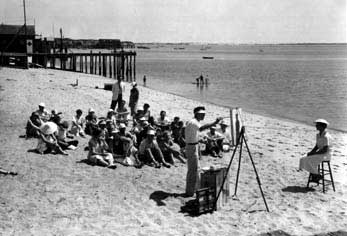
Home | Gallery
Guide | The Provincetown AIDS Art Archives Contact Us | How You Can Help
Contact Us | How You Can Help
A | B | C | D | E | F | G | H | I | J | K | L | M | N | O | P | Q | R | S | T | U | V | W | Y | Z

Hensche quotes from "Hensche on Painting: A Student's Notebook" by John W. Robichaux
When you come down to it, landscape painting really takes more skill than figure painting, excepting anatomical knowledge. The landscape painter has to draw well, he has to know the character of forms, and it has to be modeled like the body. You have to compose as in figure painting, and so on. However, from my point of view, the creation of objects and the illusion of space is just as demanding as form knowledge of the figure. Despite its complicated and varied forms, a figure is easily seen in volume. Usually painted in distance, you can see the color mass of a torso easily enough. But, take a bunch of shrubbery, you find it is difficult to figure out where one form begins and another ends. Your mind has to perceive it like the hair on the head. Unless you understand the human skull, you cannot understand the masses of hair. Yet, landscape forms are basic and harder to find, where one begins and intertwines with another. All sorts of minor forms interfere.
Whatever object you paint in light and or in shade, the color expresses
the light planes in entirely different colors than those expressed in
the shade. They are not the local color.
When it is a question of a sunny morning, then it is one light scheme.
If it is a sunny afternoon, then it is another light scheme. If it is
a gray day, another light scheme. If it is a hazy sunny day, still another
light scheme. In every case it is done in the big masses of color holding
to that light key. The single most important thing to always remember
is an object an never be seen out of the light scheme.
Think of a tree or a shrub as a box, or a sphere, or a cone for study
purposes. Block the lit side and the shadow side in the simplest way.
If you paint the landscape reduced to its simplest forms in the proper
light key it will read as the landscape you are painting. Do not try to
break the form into branches or limbs showing sunlight in the smallest
places. If your masses are not correct, all the detail in the world will
not help your painting.
[from "Henry Hensche and the Legacy" catalog, published by Provincetown Art Association and Museum, 1998, available at PAAM Museum Store]
Henry Hensche demonstrating to class, c. 1935 photograph by Peter A. Juley & Son. PAAM Archives.
..................................................
© 2001 - 2017 Provincetown Artist Registry | P.O. Box 675, North Truro, MA 02652 | 508 487-0011